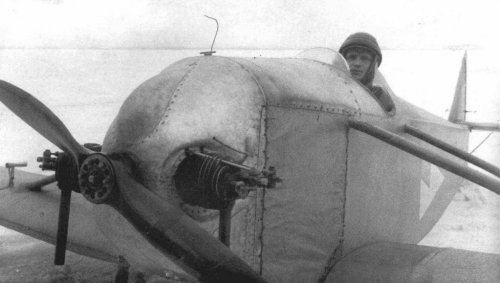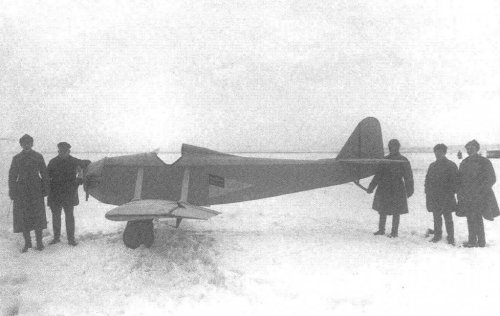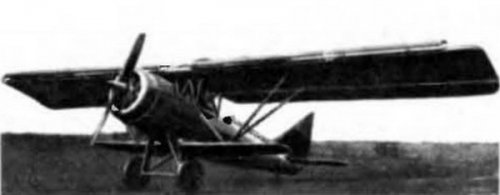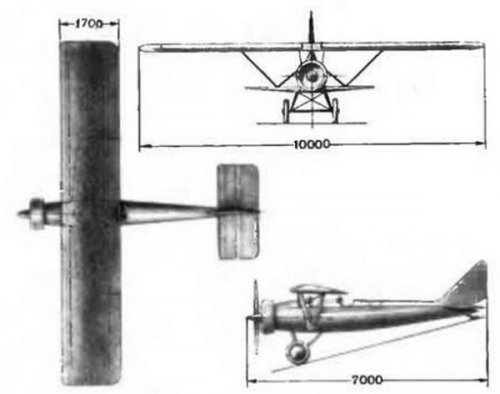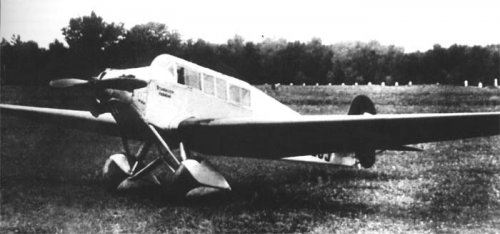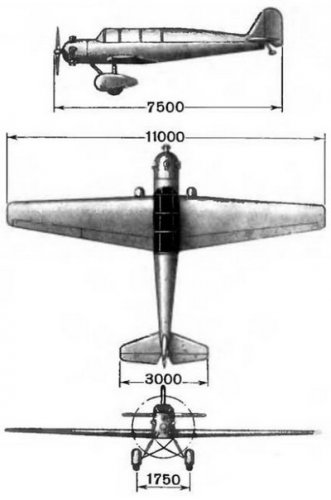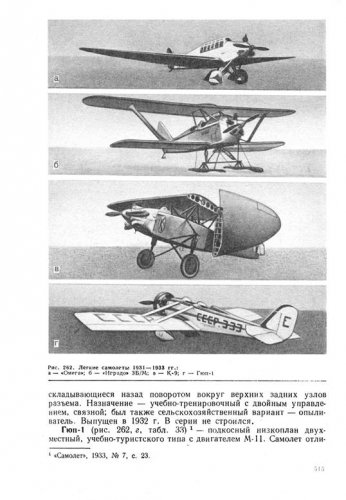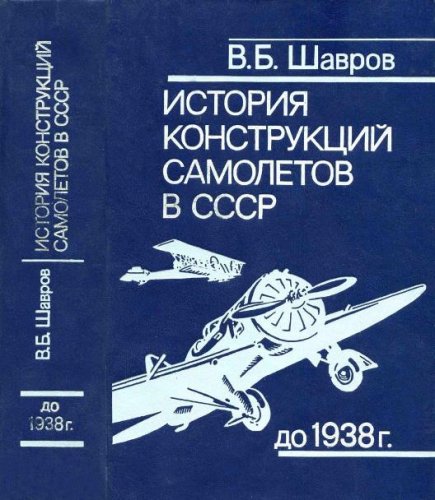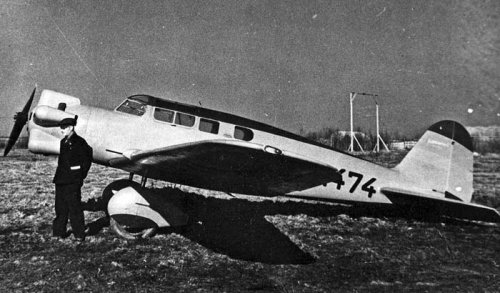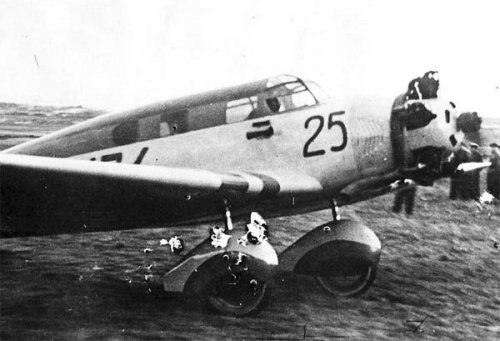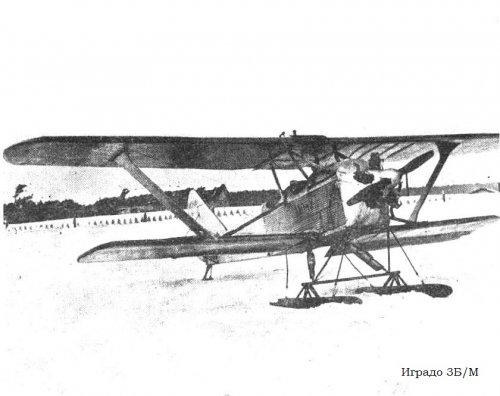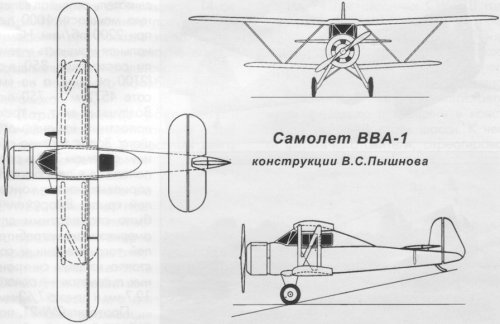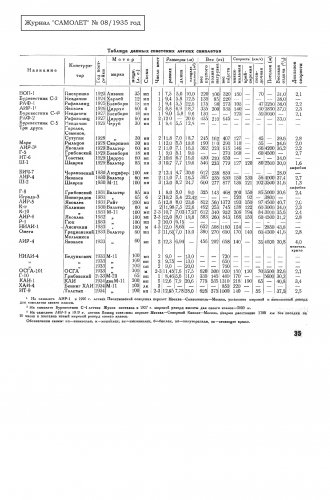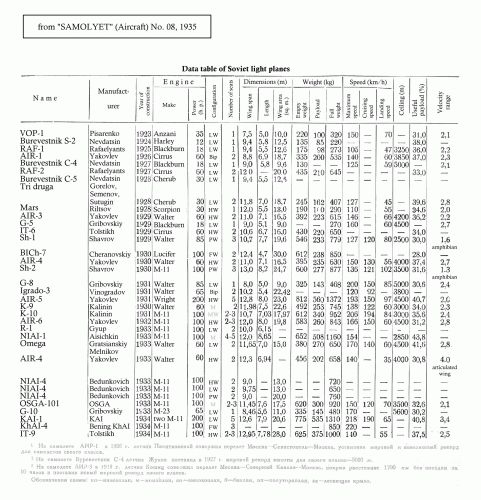You are using an out of date browser. It may not display this or other websites correctly.
You should upgrade or use an alternative browser.
You should upgrade or use an alternative browser.
Various Pre-WWII Soviet Projects & Prototypes
- Thread starter hesham
- Start date
- Joined
- 28 January 2008
- Messages
- 634
- Reaction score
- 496
In reply to post #127 and P.A. Ivensen:
The P.A. Ivensen 1929 design was single engine cantilever design with a parasol wing of wooden construction. The wingspan was 9.0 m and the wing area was 13.5 m2.
The plane was built in Smolensk, but the designer was unable to get the Bristol Cherub engine working in the aircraft due to due to previous poor storage.
In 1932 P.A. Ivenson went to work with Roberto Bartini on the Stal-6 and Stal-7 designs and also participated in the Grokhovsky G-38 aircraft. Ivensen apparently regarded Bartini as an inspirational father figure.
Ivensen also built 4 glider designs including the "Joseph Unshlikht" (1934), successfully flown solo and flown in tow from Moscow to Koktebel that year for the gliding competition.
Source:
http://eroplany.narod.ru/shavrov/chr7/civil/light2.htm
The P.A. Ivensen 1929 design was single engine cantilever design with a parasol wing of wooden construction. The wingspan was 9.0 m and the wing area was 13.5 m2.
The plane was built in Smolensk, but the designer was unable to get the Bristol Cherub engine working in the aircraft due to due to previous poor storage.
In 1932 P.A. Ivenson went to work with Roberto Bartini on the Stal-6 and Stal-7 designs and also participated in the Grokhovsky G-38 aircraft. Ivensen apparently regarded Bartini as an inspirational father figure.
Ivensen also built 4 glider designs including the "Joseph Unshlikht" (1934), successfully flown solo and flown in tow from Moscow to Koktebel that year for the gliding competition.
Source:
http://eroplany.narod.ru/shavrov/chr7/civil/light2.htm
http://www.sovplane.ru/readarticle.php?article_id=40hesham said:Hi,
Mr. S.N. Goryelov designed unusual aircraft in being STOL sesquiplane with slatted main
wing,it was a two seat light plane powered by one 85 hp Walter engine.
Attachments
- Joined
- 26 May 2006
- Messages
- 34,344
- Reaction score
- 15,008
borovik said:http://www.sovplane.ru/readarticle.php?article_id=40hesham said:Mr. S.N. Goryelov designed unusual aircraft in being STOL sesquiplane with slatted main
wing,it was a two seat light plane powered by one 85 hp Walter engine.
Nice find my dear Borovik,many thanks.
- Joined
- 26 May 2006
- Messages
- 34,344
- Reaction score
- 15,008
Many thanks my dear Cy-27,
I never hear about those four gliders.
Mr. K.R. Prokopenko designed and built a parasol wing monoplane light aircraft,
powered by one 80 hp Le Rhone engine,he killed in wing collapsed during the
last flight.
I never hear about those four gliders.
Mr. K.R. Prokopenko designed and built a parasol wing monoplane light aircraft,
powered by one 80 hp Le Rhone engine,he killed in wing collapsed during the
last flight.
http://www.sovplane.ru/readarticle.php?article_id=45hesham said:Hi,
Mr. A.N. Gratsianski designed and built the Omega,it was a low-wing cabin light
monoplane of 1931,powered by one M-23 engine.
http://www.airwar.ru/enc/law1/omega.html
Attachments
http://www.airwar.ru/enc/law1/anito1.htmlhesham said:Hi,
Mr. N.G. Nurov designed and Mr. S.A. Elibekyan built the Anito-1,it was two-seat low-wing
monoplane of 1935,powered by one M-11 engine.
Attachments
- Joined
- 26 May 2006
- Messages
- 34,344
- Reaction score
- 15,008
Hi,
Mr. S. V. Konstantinov was assistant professor at Novocherkassk,builta light aircraft,it
was not quiet Mignet typebut almost a Flea-sized regular aeroplane,powered by one 27 hp/
35 hp ABC Scorpion engine.
Mr. S. V. Konstantinov was assistant professor at Novocherkassk,builta light aircraft,it
was not quiet Mignet typebut almost a Flea-sized regular aeroplane,powered by one 27 hp/
35 hp ABC Scorpion engine.
- Joined
- 26 May 2006
- Messages
- 34,344
- Reaction score
- 15,008
Hi,
Mr. Katsur was an engineer in Kharkov,he designed a light aircraft in 1936,called VO-4,
powered by one 27 hp ABC Scorpion engine,and I don't know if there was a previous
series (VO-1 to VO-3) or not ?.
Mr. Katsur was an engineer in Kharkov,he designed a light aircraft in 1936,called VO-4,
powered by one 27 hp ABC Scorpion engine,and I don't know if there was a previous
series (VO-1 to VO-3) or not ?.
- Joined
- 28 January 2008
- Messages
- 634
- Reaction score
- 496
Mr. I.N. Vinogradov designed and built by FZU plant,the 3B/M,it was light biplane
A little bit more on the Vinogradov 3B/M "Igrado" of 1931 mentioned in Hesham's reply #136.
A sporting biplane designed by Ivan Nikolayevich Vinogradov and constructed at the FZU at Frunze in the period 1929-30. Mixed construction, forward fuselage being corrugated duralumin, the rear wood. The aeroplane had a veneer skin with wooden wings covered in fabric. It had streamlined 'I' interplane struts. It had full span ailerons on the lower wing only. The engine was a 60 hp capacity Walter 5 cylinder .
General Characteristics:
WING SPAN: 10.2 m
LENGTH: 5.4 m
WING AREA: 22.4 sq m
EMPTY WEIGHT: 500 kg
NORMAL TAKE OFF WEIGHT: 675 kg
CRUISING SPEED: 92 km/h
MAXIMUM SPEED: 120 km/h
SOURCE:
The Osprey Encyclopaedia Russian Aircraft bvy Bill Gunston (Osprey)
- Joined
- 28 January 2008
- Messages
- 634
- Reaction score
- 496
Found a bit more detail on a couple of the types mentioned earlier ...
Reply #126
Pavlov Monoplane Sportsplane
General Characteristics:
POWERPLANT: 1 x Bristol Lucifer (100 hp)
WING SPAN: 7.5 m
LENGTH: 5.5 m
MAXIMUM TAKE OFF WEIGHT: 650 kg
MAXIMUM SPEED: 190 km/h
FIRST FLIGHT: 1928
Reply #10 & #13
Pyshnov VVA-1 Trainer
High wing braced biplane with fixed undercarriage and enclosed cabin. Designed by engineer Vladimir S. Pyshnov and assembled at Zhukovsky.
General Characteristics:
POWERPLANT: 1 x Radial
WING SPAN: 11.0 m
LENGTH: 7.5 m
WING AREA: 26.00 sq m
MAXIMUM TAKE OFF WEIGHT: 850 kg
ACCOMODATION: 3
FIRST FLIGHT: 1934
Source:
Russian Civil & Military Aircraft 1884-1969 by Nowarra & Duval, Heinz J. & G.R. - Harleyford
The History Of Soviet Aircraft From 1918 by Vaclav Nemecek (Willow)
A+K Magazine 2011 (Issue 8)
Reply #126
Mr. A.N. Pavlov designed and built a single-seat high-wing light monoplane aircraft
Pavlov Monoplane Sportsplane
General Characteristics:
POWERPLANT: 1 x Bristol Lucifer (100 hp)
WING SPAN: 7.5 m
LENGTH: 5.5 m
MAXIMUM TAKE OFF WEIGHT: 650 kg
MAXIMUM SPEED: 190 km/h
FIRST FLIGHT: 1928
Reply #10 & #13
Pyshnov VVA-1:
Pyshnov VVA-1 Trainer
High wing braced biplane with fixed undercarriage and enclosed cabin. Designed by engineer Vladimir S. Pyshnov and assembled at Zhukovsky.
General Characteristics:
POWERPLANT: 1 x Radial
WING SPAN: 11.0 m
LENGTH: 7.5 m
WING AREA: 26.00 sq m
MAXIMUM TAKE OFF WEIGHT: 850 kg
ACCOMODATION: 3
FIRST FLIGHT: 1934
Source:
Russian Civil & Military Aircraft 1884-1969 by Nowarra & Duval, Heinz J. & G.R. - Harleyford
The History Of Soviet Aircraft From 1918 by Vaclav Nemecek (Willow)
A+K Magazine 2011 (Issue 8)
Attachments
- Joined
- 28 January 2008
- Messages
- 634
- Reaction score
- 496
The Pissarenko designs were mentioned earlier posts by Hesham, RedStar72 and Igor-Mich.
Pissarenko VOP-1 Light Aeroplane
This design was the first of two attractive sporting machines created by Victor Osipovich Pissarenko. It was a single seat low-wing cantilever monoplane. It had an open cockpit and was of wooden construction with birch veneer glued and pinned to form a skin. The designer took the plane up for its first flight on 27th November 1923. It was ferried to Moscow for trials and flown by over 100 pilots.
V.O.Pissarenko was lucky to obtain an Anzani engine in excellent condition and his aircraft made hundreds of successful flights.
Described by the Soviets as the first successful Soviet single-seat light aircraft. The VOP-1 built in Sevastopol at the same time as ANT-1 of completely independent design. It was first Soviet low-wing monoplane. VOP-1 was built by pilot-instructor of Sevastopol Pilot School V. O. Pissarenko, with help of cadets. No expensive materials were used, only wood and plywood. Special wing section was unique, developed by designer himself. V.O.Pissarenko had no special engineering education.
General characteristics
ENGINE: 1 x Anzani (35 hp)
WING SPAN: 7.50 m
LENGTH: 5.0 m
WING AREA: 10 sq m
EMPTY WEIGHT: 222 kg
MAXIMUM TAKE OFF WEIGHT: 322 kg
MAXIMUM FUEL: 20 kg
MAXIMUM SPEED: 120 km/h
SERVICE CEILING: 1,200 m
WING LOADING: 32 kg/m2
POWER LOADING: 9.2 kg/hp
FIRST FLIGHT: 27th November 1923
Pissarenko T Light Aeroplane
This design was a small parasol monoplane. The T (for trainer) had a good performance, better than most of its contemporaries in all classes. It was of wooden construction with ply covering on the wing leading edge and fuselage back to the cockpit which was behind the trailing edge. Wide spacing of wing bracing struts.
Reportedly it was initially studied as a Strelbom (fighter-bomber) aircraft, but was aimed at training duties. It was built at the Serpukhov School of Gunnery and Bombardment StrelBom by designer and his students (like the VOP-1). V.O.Pissarenko asked for a permit to fly it, but since no calculations were presented the permit was not issued.
Taxiing trials only were allowed. After receiving this limited permit, V.O.Pissarenko boarded the aircraft, performed some taxiing then took off anf flew to Moscow Central Airfield (Khodinka). There he managed to perform another flight (before officials were alerted), demonstrating some piloting figures. He landed successfully second time, but never tried to fly the machine again. After all this V.O.Pissarenko got an opportunity to design trainer aircraft suitable for mass production. His work was financed by UVVS, but cancelled when the N.N. Polikarpov U-2 biplane emerged.
General characteristics
ENGINE: 1 x Hispano Suiza (150 hp)
MAXIMUM SPEED: 300 km/h
FIRST FLIGHT: 1925
My feeling that the Pissarenko fighter-bomber suggestions may have derived from the fact that his designs emerged from the Serpukhov School of Gunnery and Bombardment StrelBom , the assumption being that the aircraft would be a military bomber example.
If you do a Wikipedia search for Pissarenko, there is an entry for aircraft that reads TSK -Avietka non OKB designed light aircraft - Pissarenko . Is the TSK the Pissarenko T noted above?
Sources:
Alexandre Savine WWW Pages 1998
Krilya Rodiny (no date)
Aircraft Of The Soviet Union edited by Bill Gunston (Osprey)
Pissarenko VOP-1 Light Aeroplane
This design was the first of two attractive sporting machines created by Victor Osipovich Pissarenko. It was a single seat low-wing cantilever monoplane. It had an open cockpit and was of wooden construction with birch veneer glued and pinned to form a skin. The designer took the plane up for its first flight on 27th November 1923. It was ferried to Moscow for trials and flown by over 100 pilots.
V.O.Pissarenko was lucky to obtain an Anzani engine in excellent condition and his aircraft made hundreds of successful flights.
Described by the Soviets as the first successful Soviet single-seat light aircraft. The VOP-1 built in Sevastopol at the same time as ANT-1 of completely independent design. It was first Soviet low-wing monoplane. VOP-1 was built by pilot-instructor of Sevastopol Pilot School V. O. Pissarenko, with help of cadets. No expensive materials were used, only wood and plywood. Special wing section was unique, developed by designer himself. V.O.Pissarenko had no special engineering education.
General characteristics
ENGINE: 1 x Anzani (35 hp)
WING SPAN: 7.50 m
LENGTH: 5.0 m
WING AREA: 10 sq m
EMPTY WEIGHT: 222 kg
MAXIMUM TAKE OFF WEIGHT: 322 kg
MAXIMUM FUEL: 20 kg
MAXIMUM SPEED: 120 km/h
SERVICE CEILING: 1,200 m
WING LOADING: 32 kg/m2
POWER LOADING: 9.2 kg/hp
FIRST FLIGHT: 27th November 1923
Pissarenko T Light Aeroplane
This design was a small parasol monoplane. The T (for trainer) had a good performance, better than most of its contemporaries in all classes. It was of wooden construction with ply covering on the wing leading edge and fuselage back to the cockpit which was behind the trailing edge. Wide spacing of wing bracing struts.
Reportedly it was initially studied as a Strelbom (fighter-bomber) aircraft, but was aimed at training duties. It was built at the Serpukhov School of Gunnery and Bombardment StrelBom by designer and his students (like the VOP-1). V.O.Pissarenko asked for a permit to fly it, but since no calculations were presented the permit was not issued.
Taxiing trials only were allowed. After receiving this limited permit, V.O.Pissarenko boarded the aircraft, performed some taxiing then took off anf flew to Moscow Central Airfield (Khodinka). There he managed to perform another flight (before officials were alerted), demonstrating some piloting figures. He landed successfully second time, but never tried to fly the machine again. After all this V.O.Pissarenko got an opportunity to design trainer aircraft suitable for mass production. His work was financed by UVVS, but cancelled when the N.N. Polikarpov U-2 biplane emerged.
General characteristics
ENGINE: 1 x Hispano Suiza (150 hp)
MAXIMUM SPEED: 300 km/h
FIRST FLIGHT: 1925
My feeling that the Pissarenko fighter-bomber suggestions may have derived from the fact that his designs emerged from the Serpukhov School of Gunnery and Bombardment StrelBom , the assumption being that the aircraft would be a military bomber example.
If you do a Wikipedia search for Pissarenko, there is an entry for aircraft that reads TSK -Avietka non OKB designed light aircraft - Pissarenko . Is the TSK the Pissarenko T noted above?
Sources:
Alexandre Savine WWW Pages 1998
Krilya Rodiny (no date)
Aircraft Of The Soviet Union edited by Bill Gunston (Osprey)
- Joined
- 25 June 2009
- Messages
- 14,478
- Reaction score
- 5,303
igor-mich said:The magazine "FLIGHT" № 08/1935 year
Was "SAMOLYET" simply a Russian-language version of the English "FLIGHT"? I shouldn't think so.
Also,doesn't "SAMOLYET" translate as "AIRCRAFT" rather than "FLIGHT"??
I've translated this beautiful chart for Western eyes (see attachment) leaving the bottom notes untouched (I'm not capable of handling this) and with also a couple of interrogations. Indeed, I've worked out that "NP" meant "low-wing monoplane", "VP" meant "high-wing monoplane", "PP" meant "parasol wing monoplane", "B" meant biplane, and "LK" meant "flying wing". However I'm still confused with the letters "M" and "MP", especially since the photos of the Kalinin and NIAI aircraft didn't show anything but low-wing monoplanes (I haven't a photo of the OSGA). Also, I want confirmation that "articulated wing" is a correct translation for "mekhaniz. krylo". Thanks!
Attachments
Similar threads
-
STAL-11,Italian Tourist Aircraft Project ?
- Started by hesham
- Replies: 4
-
Cheranovsky (Cheranovskii) Aircraft and Designs
- Started by hesham
- Replies: 123
-
Various Russian Prototypes and Projects During & Pre-WW1
- Started by hesham
- Replies: 144
-
New book "Bartini and His Projects - Vol.1" by Konstantin Udalov
- Started by gabrielorosco
- Replies: 11
-

